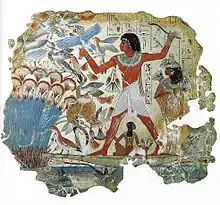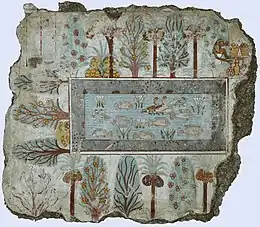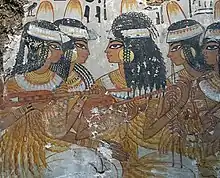Tomb of Nebamun
The Tomb of Nebamun from the 18th Dynasty was located in the Theban Necropolis located on the west bank of the Nile at Thebes (present-day Luxor), in Egypt.[1] The tomb was the source of a number of famous decorated tomb scenes that are currently on display in the British Museum, London.[1][2]
| Tomb of Nebamun | |
|---|---|
 Fowling scene | |
| Period/culture | 18th Dynasty |
| Discovered | 1820 Theban Necropolis Tomb 17 (TT17) |
| Discovered by | Giovanni (Yanni) d'Athanasi |
| Present location | British Museum, London |
| www | |
Nebamun (c 1350 BCE) was a middle-ranking official scribe and grain counter at the temple complex in Thebes. His tomb was discovered in 1820 by a young Greek, Giovanni ("Yanni") d’Athanasi, who was acting as an agent for Henry Salt, the British Consul-General.
The tomb's plastered walls were richly and skilfully decorated with lively fresco paintings, depicting idealised views of Nebamun’s life and activities. D’Athanasi and his workmen literally hacked out the pieces he wanted with knives, saws and crowbars. Salt sold these works to the British Museum in 1821, though some of other fragments became located in Berlin and possibly Cairo. D’Athanasi later died in poverty without ever revealing the tomb’s exact location.[3]
The best-known of the tomb’s paintings include Nebamun fowl hunting in the marshes, dancing girls at a banquet, and a pond in a garden.[4] In 2009, the British Museum opened up a new gallery dedicated to the display of the restored eleven wall fragments from the tomb. They have been described as the greatest paintings from ancient Egypt to have survived, and as one of the Museum's greatest treasures.[5][6]
Various scenes from the paintings have been used by artists in more modern times. Lawrence Alma-Tadema incorporated a scene of geese herding for a wall decoration depicted in his Joseph, Overseer of Pharaoh’s Granary (1874), and Paul Gauguin used part of a banquet scene as a compositional plan in his Ta Matete (1892)[7]
Gallery
 Dancers and musicians
Dancers and musicians Pond in a Garden from the Tomb, Thebes
Pond in a Garden from the Tomb, Thebes Cat attacking birds
Cat attacking birds Musicians playing Egyptian lutes.
Musicians playing Egyptian lutes. Tomb of Nebamun, Banquet
Tomb of Nebamun, Banquet
References
| Wikimedia Commons has media related to Tomb of Nebamun. |
- Salvat, Juan (1970). Historia del arte (in Spanish). Tomo 1. Barcelona: Salvat Editores, Sociedad Anónima. p. 320. ISBN 8434532433.
- "New Egyptian Gallery at the British Museum". Retrieved 2008-09-01.
- Parkinson 2008, p. 14.
- Parkinson 2008, p. 63.
- Parkinson 2008, p. 9.
- "New Egyptian Gallery at the British Museum". Retrieved 2008-09-01.
- Philip McCouat, "Lost masterpieces of ancient Egyptian art from the Nebamun tomb-chhapel" Journal of Art in Society http://artinsociety.com
Bibliography
- Parkinson, Richard B. (2008). The Painted Tomb Chapel of Nebamun. British Museum Press. p. 152. ISBN 9780714119793.CS1 maint: ref=harv (link)